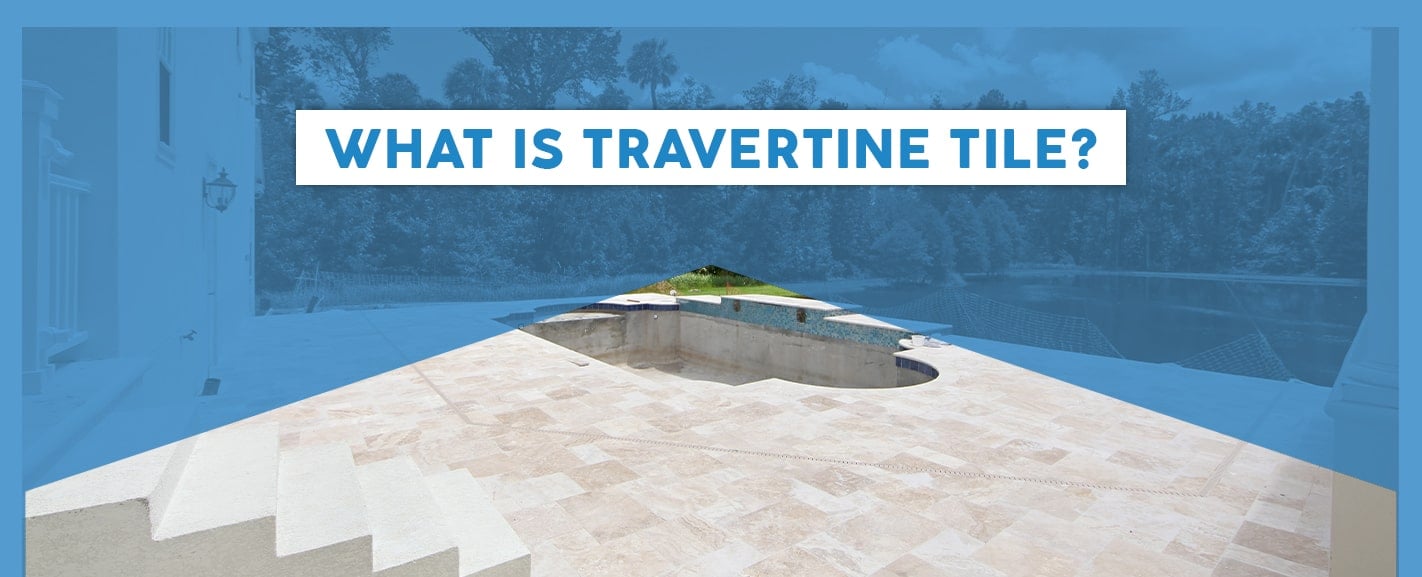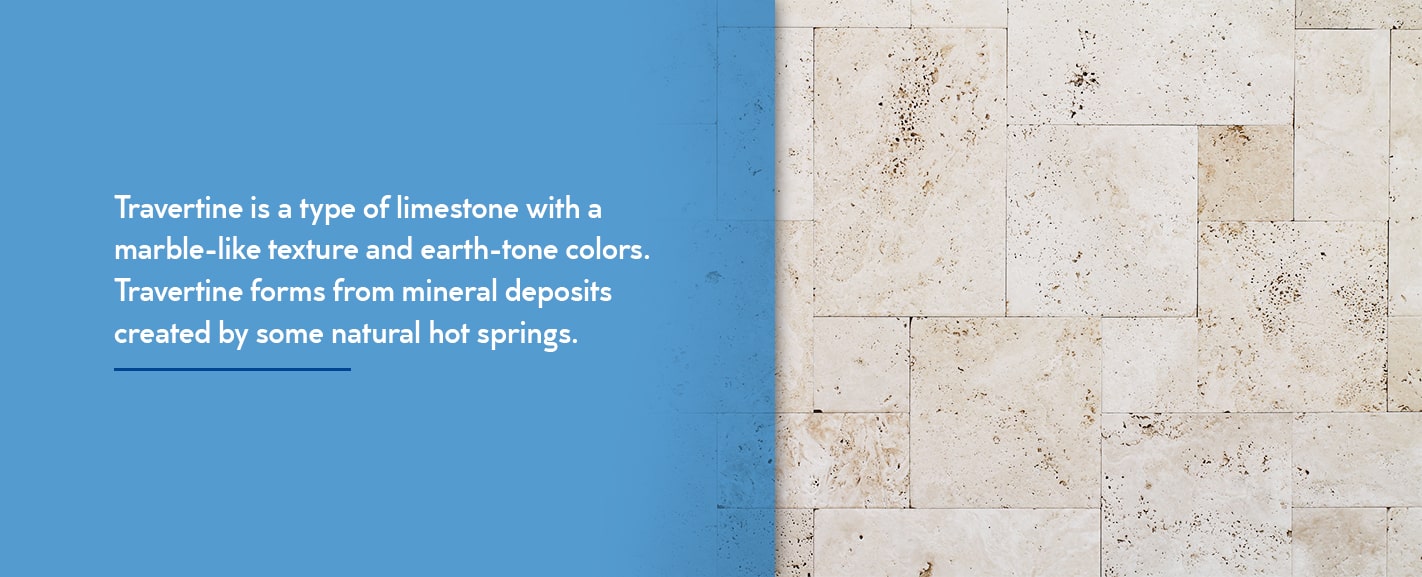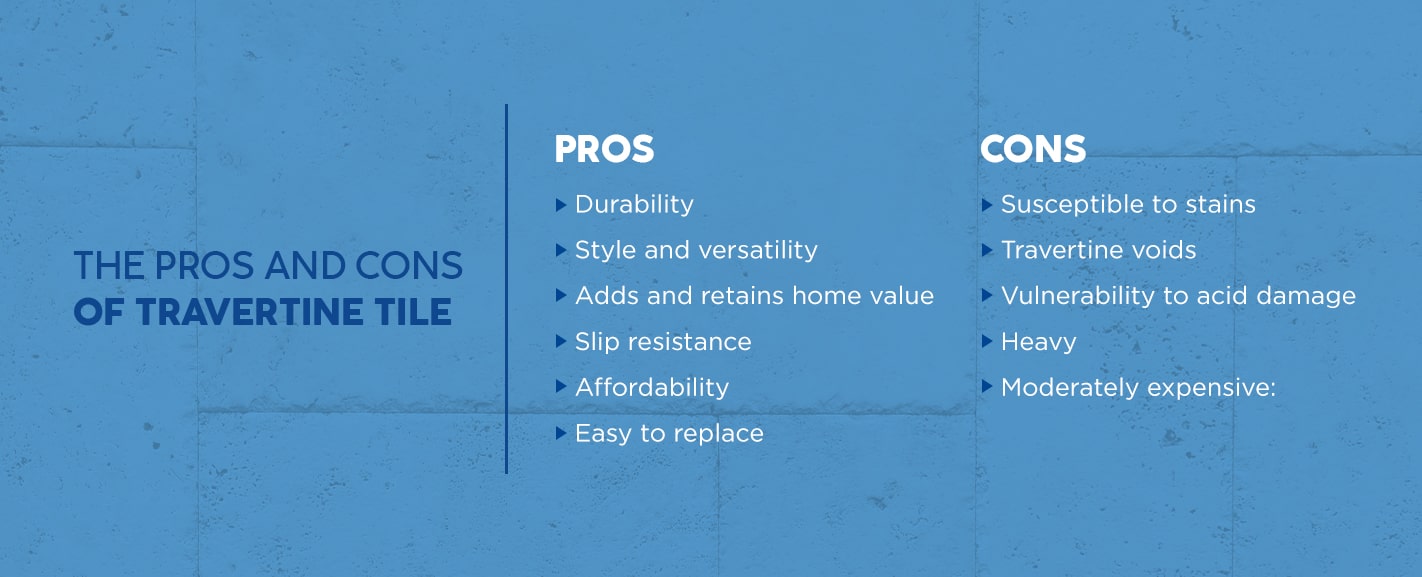

Tile floors are a classic flooring option. There is a reason tile floors have been around for thousands of years. They are practical and aesthetically pleasing. Tile floors resist moisture, are generally easy to maintain and are long-lasting.
Travertine tiles are a trendy natural flooring option that is popular for its elegance and versatility. Keep reading to learn more about what travertine is, its flooring applications and how it stacks up against other flooring options.
What Is Travertine?
Travertine is a type of limestone with a marble-like texture and earth-tone colors. Travertine forms from mineral deposits created by some natural hot springs. Travertine forms with unique swirls caused by calcium carbide passing through and mixing with other minerals. Travertine’s distinctive, striking appearance makes it one of the most popular stones for flooring.


Types of Travertine Tile
Travertine is incredibly versatile. In addition to being appropriate for backsplashes and flooring, it comes in various finishes and colors for a wide range of style options.
Finishes
There are four main types of travertine tile styles, determined by the finish of the cut. These different finish options help you find the perfect look to match your style.
- Polished: Polished travertine smoothed and glossed over to create a reflective marble-like finish.
- Brushed: Brushed travertine has a slightly rough texture and a matte finish that highlights the stone’s natural beauty. Manufacturers achieve this finish by treating the travertine with a wire brush to reach the desired texture.
- Honed: Honed travertine, the most popular finish for home flooring, is the midpoint between a polished and brushed finish. Honed travertine is lightly polished for a smooth yet matte finish.
- Tumbled: Tumbled travertine goes through a unique treatment for an aged, rustic look. Manufacturers achieve this finish by placing the cut stones in a plastic barrel with abrasive grit and water and rotating the barrel to allow the stones to rub against each other as they tumble. As a result, tumbled travertine tiles have a highly textured finish with rounded corners and edges perfect for a beautiful antique feel.
Cuts
Besides finish, another factor determining travertine tiles’ appearance is the type of cut. The same stone can look dramatically different depending on the direction of the cut relative to the bedding of the stone. The bedding of travertine is the pattern in the rock, similar to the grain in a piece of wood. The two types of cut are vein cut and cross-cut.
To achieve a vein cut, slice the travertine in the direction of its bedding. A vein cut creates a linear pattern that displays the lines of the bedding plane. In contrast, a cross-cut exposes a random, often circular pattern by cutting parallel to the bedding plane. This circular pattern is somewhat similar to the ring-like patterns you see from cutting a tree across the grain.
Colors
The multitude of color options further increases the diversity of styling options offered by travertine tiles. The colors present in the stone will vary depending on the minerals present when the material formed. Travertine tiles are never a single solid color. The patterns are distinct with different mottling and bands of contrasting colors throughout, though some types of travertine are more consistent in color than others.
While each tile is unique, stones mined from the same area will be similar enough to create a beautiful floor with a bit of planning and a thoughtful layout. The stone’s natural variation means that every travertine floor has a unique look. The range of colors includes different shades of beige, brown, gray and more exotic colors like red, pink and green.
Travertine Flooring Costs
Though more expensive than low-end flooring options like laminate, travertine is reasonably priced compared to other natural stone options like marble. If you want a classic stone look, travertine’s affordability and exquisite appearance make it an excellent choice. Travertine’s price can vary widely depending on the stone’s quality and finish. Generally, polished travertine will be more expensive than a natural texture. Installation costs may vary as well. As the material is heavy, it sometimes requires structural reinforcements. To get a more detailed estimate, reach out to a flooring specialist. At 50Floor, we offer free in-home consultations with our flooring experts.
The Pros and Cons of Travertine Tile
When choosing a flooring material for your home, it is crucial to consider the pros and cons of each option and compare those against your family’s needs. Like any other material, travertine has various strengths and drawbacks that make it more suitable for some applications than others. Some of these features will depend on the stone’s finish and cut.


Pros
- Durability: Travertine is remarkably durable and ages stunningly well. Ancient Roman engineers used it in iconic structures that still stand today, including the Colosseum and the Trevi Fountain. Travertine is a hard stone that doesn’t easily show scratches. Natural finishes like brushed or tumbled are more resilient to damage and less likely to show nicks and scratches than polished or honed tiles. Keep this in mind if you want to maximize your floor’s lifespan.
- Style and versatility: Travertine’s range of finishes and color options gives you the flexibility to match any kind of decor. You can go for a classic natural look or a polished modern flair. The possibilities are nearly endless.
- Adds and retains home value: Travertine floors’ longevity and style can boost your home’s value. Durable floors that age gracefully will hold their value over time better than less resilient options requiring more frequent repairs and refinishing.
- Slip resistance: Unpolished travertine has a rough, non-slip texture, making it great for areas like bathrooms and alongside pools where traction is essential.
- Affordability: Travertine is generally less expensive than other natural stone flooring options like marble or granite. You can save money without sacrificing quality.
- Easy to replace: You can remove and replace individual tiles in the rare event that they get broken or damaged, meaning repairs are inexpensive and straightforward if you save some extra tiles during installation.
Cons
- Susceptible to stains: Travertine is porous, meaning it is full of tiny holes. Porous stones like travertine have a handful of drawbacks. For starters, these microscopic pores allow liquids to penetrate, which makes the stone stain easily. You can protect against stains by applying a penetrating sealer. You will need to reapply the seal every few years.
- Travertine voids: Another potential downside of travertine being porous is travertine voids, small visible holes resulting from gases getting stuck in the rock as it formed. Polished and honed travertine comes with these surface voids filled, but holes just below the surface become exposed over time as the floor wears. Filling these holes in as they appear is acceptable and common practice. Alternatively, you could choose the unpolished finish and embrace the distinct rustic feel of weathered travertine.
- Vulnerability to acid damage: Travertine, like marble, is a calcareous stone. In other words, it is mainly calcium carbonate, which means you have to be careful what cleaning solutions you use. Using vinegar, lemon juice or other acidic cleaning products will stain travertine floors.
- Heavy: As you’d expect, stone tiles tend to be heavy, making them challenging and time-consuming to install. You will likely need to hire a skilled professional. The tiles’ weight also requires a strong and stiff subfloor to support them without excessive bowing or flexing. You may need to reinforce your subfloor’s structure before installing the tiles. Lastly, depending on how you are getting the tiles to your home, you may have to pay more in transportation costs than you would for a lighter material.
- Moderately expensive: Though less costly than other natural stones like marble, travertine tile flooring is still more expensive than alternative materials such as laminate or vinyl. You can offset this cost by how long stone tiles last and how well they retain their value, but if upfront costs are your primary concern, travertine may not be the right choice.
How to Clean and Maintain Travertine Tile
While travertine can be exceptionally durable, it has some unique cleaning and maintenance considerations. If cleaned and cared for properly, travertine floors will maintain their beauty for decades with only a moderate amount of upkeep.
Before you start cleaning, it is crucial to ensure you are using the correct supplies. As noted before, many everyday cleaning solutions such as vinegar are acidic and will stain and damage travertine tiles. When cleaning travertine tile, make sure you are using pH-neutral, non-abrasive cleaners. Dish soap is a gentle detergent and is safe to use occasionally, but not more than three or four times a year. The best choice would be a cleaning product specifically formulated for travertine. To be safe, check your flooring warranty to see what chemicals to use or avoid. You should also start by testing a small, inconspicuous area to ensure it does not stain before cleaning your entire floor with any product for the first time.
Once you have gathered all your cleaning supplies, your first step will be to remove dust and dirt from the surface. You can do this with a broom, dust mop or vacuum. If using a vacuum cleaner, be careful not to damage the floor. Use a vacuum with a hard floor setting and soft attachments to avoid chipping or scratching the tile. Sweeping a couple of times a week will prevent the buildup of small rocks and dust that can scratch and wear stone tiles if allowed to accumulate.
You should mop your travertine floor once a week after sweeping. Warm water without any chemicals or detergents will usually be sufficient. You can add dish soap or another cleaning solution designed for stone floors as a disinfectant. If you are adding a cleaning solution, check your warranty first and follow the directions for the product. If using dish soap, only use a small squirt.
Excess water can penetrate the sealant and settle into the porous stone, causing damage and discoloration. To avoid this, wring the mop out thoroughly as you clean. After mopping the first time, rinse the floor with a clean, wet mop. This step is especially crucial if you used a cleaning solution, as a second pass will remove any residue left behind during the initial cleaning. After mopping, dry the floor with a soft cloth or towel to remove any remaining moisture.
In addition to regular cleaning, you will occasionally need to apply a sealant to the floor to protect against stains, discoloration and degradation caused by moisture penetrating the travertine. Various sealers have different lifespans. Some need annual application, while others can last as long as five years. If you prefer a darker glossy appearance, reapply your sealant more frequently. If you are going for a more weathered antique look, use a natural sealer and apply it less often.
Before applying a sealant, you should always check the directions for the sealer and check your floor manufacturer’s warranty and instructions, especially if you are switching from one product to another.
Travertine Tile Aesthetic


Whether you are going for a traditional or modern look, travertine can fit your decor thanks to the range of tones and textures it comes in. Despite the diversity of colors available, shades of beige are the most commonplace. You might already have this popular look in your house. Here are some style tips for coordinating your travertine floors with your home decor.
For a classic Mediterranean style, pile on additional warm neutral colors like tan and brown with your furniture and decorations to give the room a sophisticated, muted look.
If you prefer something more modern and a little less monochromatic, some bright colors pair well with beige flooring. Blue is an excellent complement for travertine tile floors. Blue tones down the ordinary beige, yellow and pink shades of travertine without creating a sharp clashing contrast. Try blending the room with a range of blues from light slate blue to a dark navy. Alternatively, go for a darker color scheme by introducing dark browns and shades of bronze with a navy blue accent.
A dark green or peacock color can provide a similar aesthetic to navy blue. The dark colors create a strong contrast between the travertine’s light tones, making the floor less pronounced. Try pairing the green shades with light-colored accents like soft white to pull the room together.
Another surprising but sharp-looking choice is pairing beige and gray. Mixing either dark gray or a warm medium gray with beige can create a beautifully sophisticated color palette. Charcoal gray with white accents cools the room and makes pinkish-beige rooms seem more neutral. Fortunately, many fabrics mix gray and beige, providing many options for selecting furniture and draperies that match this color scheme.
Travertine vs. Porcelain Tiles
If you are considering a travertine tile floor, you have likely looked at similar alternatives as well. Porcelain tiles are a remarkable substitute for travertine floors. Porcelain tiles have many of the same benefits as travertine. Manufactured tile can mimic the look of natural stone or other materials, including hardwood. The styles, colors and textures available even exceed that of the wonderfully versatile travertine. Properly maintained travertine tile has a longer life expectancy than porcelain tiles. However, the 75 to 100 years tiles tend to last is long enough that the difference is insignificant for most purposes.
Porcelain tiles have some benefits over travertine that are worth mentioning. Perhaps the most notable difference is that porcelain is not porous. That means you do not need to worry about sealing the tiles or staining them by exposing them to moisture.
Another benefit of porcelain is that you can safely apply more cleaning solutions to it. Many common cleaners and disinfectants, including vinegar, are acidic and will stain travertine. You should still check with your manufacturer before using chemical cleaners on your porcelain tile floor.
Lastly, porcelain tiles tend to be cheaper than travertine. The tiles themselves generally cost less, and the installation cost is usually lower as well. Like travertine, the cost of porcelain tiles can vary significantly based on many factors. The price range of the two materials overlaps somewhat, meaning you may find travertine to be the cheaper alternative.
While porcelain tiles have some noticeable benefits over travertine, that does not necessarily mean porcelain tiles are the clear-cut winner. Though porcelain tiles can look and feel similar to travertine, it is not entirely the same. Furthermore, manufactured tiles will not achieve the one-of-a-kind look of naturally formed stone.
Contact 50Floor for All Your Flooring Needs
Whether you are looking to install travertine, porcelain or any other flooring, 50Floors is here to help. Our flooring experts will provide you with a free consultation to navigate you through the different flooring products we have available.
We believe it should be as easy and convenient as possible to find affordable quality flooring. With 50Floor, you don’t even have to leave the comfort of your home. We come to you with a range of flooring samples, so you can envision how your new flooring will match the rest of your home. Schedule an appointment today.




